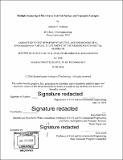Multiple scattering of microwaves from soil surface and vegetation canopies
Author(s)
Feldman, Andrew F
DownloadFull printable version (12.68Mb)
Other Contributors
Massachusetts Institute of Technology. Department of Civil and Environmental Engineering.
Advisor
Dara Entekhabi.
Terms of use
Metadata
Show full item recordAbstract
A multiple scattering radiative transfer model is developed for use in global retrieval algorithms of microwave geophysical parameters. This attempts to both improve soil moisture and vegetation attenuation and scattering parameter retrievals under moderate to dense canopy covers and capture the full microwave vegetation signature. The model is developed using a ray tracing method of first-order interactions with canopy constituents larger than 21 cm (e.g. woody biomass). It introduces only one new variable, [omega]₁ representing scattering from these constituents, making it almost as computationally efficient to implement as the commonly used tau-omega (zeroth-order) model. With concerns for vegetation cover changes with climate change, there is motivation to monitor vegetation cover properties and respective available surface water availability. The retrieval of microwave vegetation attenuation and scattering parameters provides a unique opportunity to monitor vegetation parameters in addition to commonly used optical remote sensing of vegetation techniques. The model is applied within the recently developed and hereby enhanced Multi-Temporal Dual Channel Algorithm (MT-DCA) framework. The algorithm is implemented over Africa using SMAP 36 km brightness temperature radiometric measurements using both zeroth and first-order radiative transfer models. The first-order radiative transfer model is determined to be more sensitive to surface emission resulting in an improved surface emission signature from retrievals. The retrieved [omega]₁ are also greatest in forests noting the presence of woody biomass and resulting in first-order emission contributing to 5% of the total emission. Consequently, changes from zeroth to first-order retrievals occur primarily in vegetated regions where [omega]₁ is non-zero. Non-zero [omega]₁ additionally results in improved fit of parameters to SMAP measurements. Without a comprehensive forest in-situ measurement campaign, it is inconclusive whether the introduced first-order radiative transfer model improves retrievals over SMAP and SMOS baseline retrievals. Additionally, further work in developing global retrieval algorithms aimed at retrieving both surface and vegetation microwave parameters amongst moderate to dense vegetation is encouraged.
Description
Thesis: S.M., Massachusetts Institute of Technology, Department of Civil and Environmental Engineering, 2018. Cataloged from PDF version of thesis. Includes bibliographical references (pages 67-71).
Date issued
2018Department
Massachusetts Institute of Technology. Department of Civil and Environmental EngineeringPublisher
Massachusetts Institute of Technology
Keywords
Civil and Environmental Engineering.